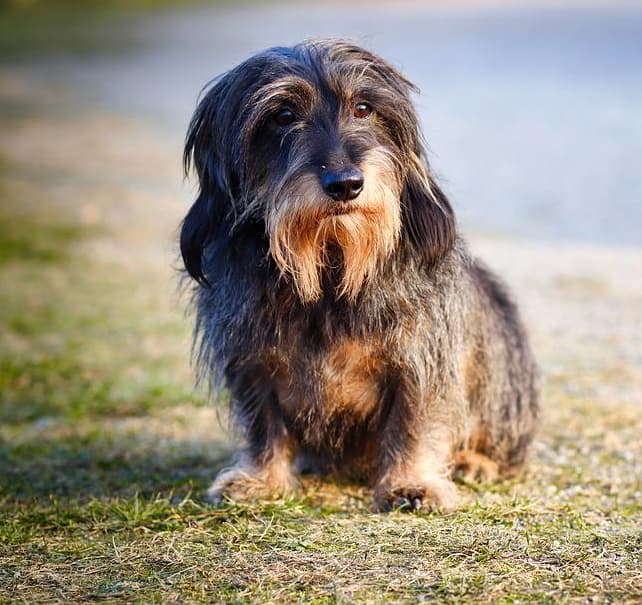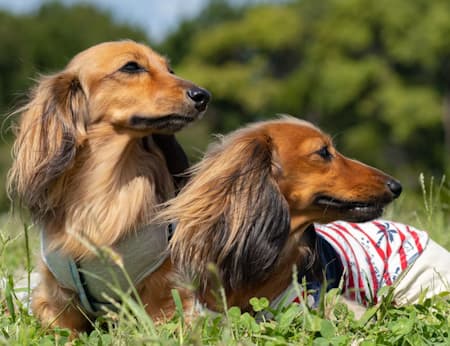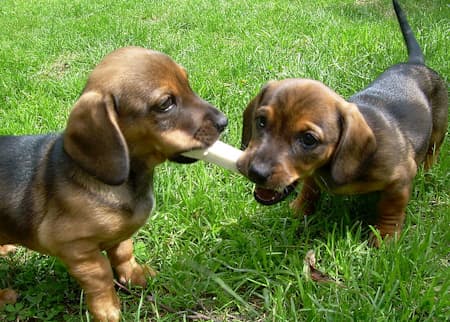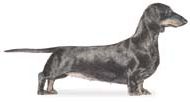Dachshund (Doxie) – Breed Profile, Traits & Care Tips

The Dachshund is a hardy breed well known for its keen tracking and scenting abilities. Their hunting life began about three hundred years ago when they were bred to go into burrows after badgers, hares, and stoats.
In fact, "Badger dog" is the translated version of their name - a name that was widely used during WWII to keep them from being shunned.
Dachshunds are still used for hunting in some parts of Europe.
🐾 Dachshund Quick Facts
- Breed Group: Hound (AKC)
- Origin: Germany
- Size: Standard (16–32 lbs) · Miniature (under 11 lbs)
- Height: 8–9 in (Standard) · 5–6 in (Miniature)
- Coat Types: Smooth, Longhaired, Wirehaired
- Colors: Black & Tan, Red, Chocolate, Dapple, etc.
- Life Expectancy: 12–16 years
- Temperament: Playful, clever, devoted, sometimes stubborn
- Exercise Needs: Moderate (daily walk + playtime)
- Special Considerations: Prone to back issues — avoid jumping
💡 Helpful for Dachshunds
Dachshunds are prone to spinal issues, so ramps can make a big difference in protecting their backs.
👉 See the Best Ramps for DachshundsAffectionately referred to as Doxies or Wiener dogs, the breed comes in two varieties: standard and miniature. Today, they’re beloved companions thanks to their lively personality and distinctive appearance.
As far as their ancestry is concerned, there is some evidence that suggesting they may be descended from a similar-looking dog that existed in ancient times in Egypt.
Characteristics of the Dachshund
Dachshunds are sweet, clever, amusing, courageous, and intelligent. However, they can be independent and difficult to train. Strong leadership and proper training are needed right from the beginning to bring out the best in them.
Without consistent leadership, this cute little dog will try to take charge and develop a bossy attitude toward family members, leading to unwanted behaviors. Starting training early helps avoid these issues.

As a family companion, Doxies are very loyal and make good watchdogs. They are prone to weight gain, so keeping a close watch on their diet is important.
The long-haired variety is often said to have a more mellow temperament, but that may just be an urban legend!
Appearance And Care
Height: Standard 8–9 inches, Miniature 5–6 inches
Weight: Standard 16–32 pounds, Miniature up to 11 pounds
Standard color variations: Solid – red or yellow; 2-color – black, chocolate, or gray with tan; white/yellow; or dappled

There are three coat types found in the breed: smooth/short-haired, long-haired, and wire-haired.
They’re instantly recognizable by their elongated bodies and short legs, features that helped them dig into burrows during hunts.
All Doxie coat types shed to varying degrees. Unlike some breeds with continuously growing hair, Dachshunds have fur that follows a regular shedding cycle, which can result in year-round shedding. The amount of shedding depends on the coat type.
While overall shedding in the breed is moderate, seasonal changes may increase the amount.
The short/smooth coat benefits from a regular rubdown with a damp cloth. Some owners also choose hand-stripping once or twice a year to keep the coat in top condition.
The long-haired coat needs more attention - requiring daily brushing to avoid matting along with an occasional trim.
To keep the wire-haired coat healthy, brush it 2-3 times per week or even daily if possible. This coat is prone to tangle so you may need a de-tangling spray. Follow the "matting" link above for tips.
General care of the Dachshund includes brushing, bathing as needed, nail trimming, and regular teeth brushing. Their ears should also be cleaned and checked often for signs of infection or mites.
Fortunately, Doxies are naturally pretty clean dogs with low dog odor.
Recommended Brushes/Combs:
Smooth Coat: Chris Christensen Boar Brush at Amazon
Long-haired: Chris Christensen Oval Pin Brush at Amazon
Wire-haired: Karben Slicker Brush at Amazon
and a Buttercomb at Amazon

Health
Families with Dachshunds may expect to enjoy their pet for up to 16 years with good nutrition and veterinary care.
Canine diseases that are associated with the breed include:
- IVDD - Intervertebral disk disease: A serious and painful condition where the discs between the vertebrae are subject to degeneration, extrusion, protrusion and herniation. In humans, a similar condition is often called a “slipped” or herniated disc.
- Patella Luxation
(Slipping Kneecap):
As the name implies, this involves a dislocation of the kneecap to varying degrees and is usually an inherited defect and more common in toy or smaller breeds. Responsible breeders will screen more than one generation of parents for this condition, before breeding, as well as the resulting puppies, before they are offered for purchase. A common early sign is intermittent limping.
- Epilepsy (inherited) A neurological disease that results in seizures without a know cause. Medication can often help manage and reduce the frequency of seizures.
- Eye conditions including PRA - Progressive Retinal Atrophy: This is linked to a recessive gene mutation and is identified by a failing of the rods and cones of the retina. Sadly it leads to vision loss. Fortunately, a DNA test is now available to detect one form of its presence in affected dogs, providing valuable information to breeders.
- Cataracts: A clouding of the lens that reduces vision.
Because of their long spine, Doxies should be discouraged from excessive jumping, as it increases the risk of back problems. Also, keep an eye on their weight for the same reason.
Tip: Many owners use ramps or steps to help their Doxies get onto furniture safely.
 Bartłomiej Derski, CC BY-SA 4.0, via Wikimedia Commons
Bartłomiej Derski, CC BY-SA 4.0, via Wikimedia CommonsHow Active is the Dachshund?
This breed is fairly energetic and should be taken out for walks a
couple of times a day to stay fit and
help strengthen their back muscles.
Regular exercise is a key part of maintaining both their health and weight.
The Doxie
is perfectly content to lounge around, but without regular activity and mindful feeding, they can quickly gain weight.
While Doxies are very playful little dogs, it is recommended that they be discouraged from jumping on or off furniture and from frequent stair climbing due their combination of a long back and short legs which poses a risk for spinal injuries.
That said, if you like your dogs to have access to furniture or beds, consider using dog ramps from an early age to protect their back.

Ideal Living Space
This small dog will be comfortable in either a house or apartment, though homes without many stairs are best due to their long backs and short legs. .
Be aware that they can be barkers, so if
you have close neighbors, it’s wise to teach a “quiet” command early to keep the peace.
Dachshunds With Kids?
They’re great playmates for respectful older children, but may become defensive if handled roughly by
younger kids.
The best policy - no matter what the breed - is to always have an adult present to supervise play between kids and dogs.
With Seniors Or Less Active Families?
The Dachshund is a good breed for seniors or more sedentary families as long as they receive appropriate exercise and portion-controlled meals to prevent weight gain.
While exercise requirements are not demanding, consider short, regular walks or gentle play sessions to keep your Doxie happy and healthy.
Where to Buy or Rescue a Dachshund
If you're thinking about buying or rescuing a dachshund, begin by contacting reputable organizations such as:
These organizations are reliable places to help you find a Dachshund puppy or adult Doxie to adopt, rescue, or buy.
If purchasing a purebred Dachshund puppy from reputable source, expect to pay between $500 and $3,000 depending on several factors, such as health testing, pedigree, breed type, and reputation of the breeder. Many breeders on platforms like the AKC Marketplace charge around $1,500 on average.
It is recommended to avoid casual (or backyard) breeders, since these breeders may not prioritize the health of the puppies or perform proper health testing on the parents.
FAQs

🛒 Keep Your Doxie Healthy & Happy
Want to help protect your Dachshund’s back? Check out our guide to the best ramps and other back-friendly products.
👉 See Our Recommended Ramps & StepsBefore You Go...
If you like the content of this page, as well as others on my site, please give it some love by clicking on the heart in the lower right hand corner. This helps me keep providing enjoyable and useful content.
Thank you.
Vet-Reviewed Sources:
About this article:
Fact-checked with vet-reviewed sources including
the American Animal Hospital Association; American Animal Hospital
Association; ASPCA; the Merck Veterinary Manual and more to ensure accuracy
and safe, practical advice for pet owners.
- Home ›
- AKC Breeds ›
- Dachshund



